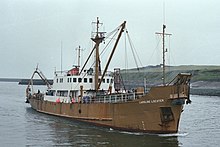HMS Blackburn (1944)
HMS Blackburn was the lead ship of a class of small aircraft transporters built by the British Royal Navy during World War II . After the end of the war, it was initially used as a training ship and then, under the name of Gardline Locater, as a research ship and supplier for the oil and gas industry in the North Sea .
history

The ship was on 25 March 1944 during the Blyth Shipbuilding Company in Blyth (Northumberland) with the hull number 311 from the stack . It was 52.43 m long and 9.14 m wide and displaced 990 t . The propulsion system consisted of two 8-cylinder marine diesel engines . The purpose of the ship was to transport aircraft and spare parts along the British coast .
In 1950 the Blackburn was converted into a training ship for the Royal Navy Volunteer Reserve (RNVR).
She was sold in 1970 to the "Harry Pounds Scrapyard" shipyard in Portsmouth , which renamed the ship Harpounds ( IMO number 7048063) and used it as a tug . It was resold in 1974 to the shipping company Gardline Shipping in Great Yarmouth , which was founded in 1969 as an offshore service provider for the oil and gas industry in the North Sea. The shipping company had the ship converted to a research ship (747 GRT ) and renamed it Isis Locater and in 1975 Gardline Locater . The home port was Lowestoft .
In July 1985, the ship played a crucial role in locating the cockpit voice recorder (CVR) and flight data recorder (FDR) of the Air Boeing 747, which fell into the Atlantic on June 23, 1985 with 329 people on board as a result of a bomb explosion off the coast of Ireland India Flight 182 . It was the Gardline Locater sonar that picked up the signals from the CVR and FDR on July 9, 1985. The two devices were then lifted from 2040 meters water depth on July 9th and 10th by the diving robot Scarab 1 , launched and controlled by the French cable ship Léon Thévenin , and sent to India two days later for evaluation.
The Gardline Locater was scrapped in Singapore in August 1997 .
Footnotes
- ^ JJ Colledge, Ben Warlow: Ships of the Royal Navy: The Complete Record of all Fighting Ships of the Royal Navy, Chatham Book, Casemate, Philadelphia & Newbury, 2010, ISBN 978-1-935149-07-1 , p. 45
- ↑ a b c d Miramar Ship Index, IMO 7048063, dates and owner of the ship , accessed on December 22, 2019
- ↑ Ships Nostalgia Gallery, Gardline Locater , accessed on 22 December 2019
- ↑ = Submerged Craft Assisting Repair and Burial
- ↑ "6000 Feet Down, Robot Grabs Air-India Jet Recorder" ( Los Angeles Times , July 11, 1985)
- ^ "First salvage raised from Air India crash", New Scientist , July 11, 1985, pp. 26-27
literature
- JJ Colledge, Ben Warlow: Ships of the Royal Navy: The Complete Record of all Fighting Ships of the Royal Navy, Chatham Book, Casemate, Philadelphia & Newbury, 2010, ISBN 978-1-935149-07-1 , p. 45
- Maurice Cocker: Aircraft-carrying ships of the Royal Navy , History Press, Stroud (Gloucestershire), 2008, ISBN 0752446339 , pp. 125-126